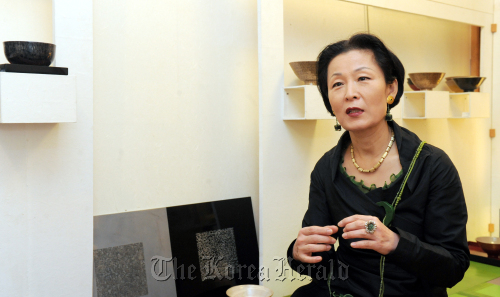Kim Kyung-shin knocks on Korea with accessories and dinnerware using hanji and lacquer
The artist’s atelier is located in “hanok,” or traditional house, in Bukchon, central Seoul.
Small signs reading Kyung Shin Kong Bang (Kyungshin Crafthouse) in Chinese letters hang at several corners of the area’s narrow alleys to guide the visitors.
Kim Kyung-shin, a South Korean craft artist, lives, works and exhibits her works there. But she is less well-known here than in Germany, where she lived and worked for about 20 years, amazing the craft market there with her unique jewelry and lightings made of “hanji,” or traditional Korean paper.
She won the prestigious first prize of the State of Hessen, Germany, in craftwork in 1998, only two years after she graduated Pforzheim, where she studied jewelry and sculpture. In 2007, she won the silver medal in the 27th International Innovation Fair held in Geneva, Switzerland.
Kim said that her booths at fairs were always packed with buyers. Though her works are pricy -- tiny brooches made of metal and hanji start at 650,000 won -- Europeans and Americans thought they were worth the money.
 |
Kim Kyung-shin speaks at her atelier. (Ahn Hoon/The Korea Herald) |
“I was thrilled in 2002 when I first participated in SOFA (International Exposition of Sculpture Objects and Functional Art). All of the world’s famous artists were there and my heart was racing. But guess what? People started to crowd over at my booth, and without realizing, I was the queen,” said Kim.
Her accomplishments so far are remarkable, especially considering how late she started. After graduating high school, she worked at a bank for nine years. The job was fun in its own way, but the art museums and galleries near her workplace in Insa-dong, always attracted her more.
Making the decision of her life, she flew off to Germany, the birthplace of the Bauhaus movement. Her teachers were amazed by how her works were so different from others’.
“They found hanji so artistic. When a drop of water smeared on the paper, professors would say ‘Kyung-shin, this is art. Don’t touch it any more,” Kim reminisced.
“What was most important was that I was Korean and my principal material was hanji. Hanji was probably the first thing that I saw when I was born. I know Koreans can ace in the field, only if we believe in ourselves,” said the artist who was born and grew up in the Bukchon area, surrounded with hanji-covered doors.
She only half agreed, though, that she had more luck in Europe with hanji because Westerners were unfamiliar with the material.
“Europeans are exposed to various genres of culture like art and music as they grow up. They do not particularly think that paper is precious either. But they do recognize how it is made into art and luxury when added with structural beauty.”
Since 2005, Kim has been making lacquered tableware, and plans to expand her field into interior design. She will participate at the Design & Art Fair 2012 on April 21-29 at the Seoul Arts Center.
“It hurts my pride to think why Korean brands are not topping the world market although we have the most and the best artists. I have been satisfied by creating a small number of masterpieces, but now I am feeling the need to create my own Kyung-shin brand,” said Kim.
By Park Min-young (
claire@heraldcorp.com)





![[Weekender] Korea's traditional sauce culture gains global recognition](http://res.heraldm.com/phpwas/restmb_idxmake.php?idx=644&simg=/content/image/2024/11/21/20241121050153_0.jpg)


